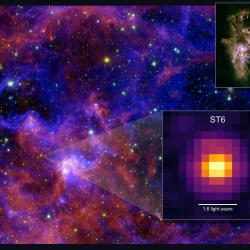Comet’s Brush With Mars Offers Opportunity, Not Danger
UMD astronomers study “fresh” comet’s first approach to the sun
Comet Siding Spring will brush astonishingly close to Mars later this year – close enough to raise concerns about the safety of a fleet of spacecraft orbiting the Red Planet. But after observing Siding Spring through a satellite-mounted telescope, University of Maryland comet experts found that it poses little danger to the Mars craft. The spacecraft will be able to get an unprecedented close look at the changes happening to this “fresh” comet as it nears the sun – as well as any changes its passing may trigger in the Martian atmosphere.
Fresh comets like Siding Spring, which have never before approached the sun, contain some of the most ancient material scientists can study. The UMD astronomers’ observations are part of a two-year-long research campaign to watch how the comet's activity changes during its travels.
"Comet Siding Spring is making its first passage through the inner solar system and is experiencing its first strong heating from the sun," said UMD assistant research scientist Dennis Bodewits, lead researcher on the UMD astronomy team that used NASA’s Swift satellite to estimate the comet’s size and activity. “Comets like this one, which formed long ago and remained for billions of years in the icy regions beyond Pluto, still contain the primeval building materials of our solar system in their original state.”
The solid part of a comet, called its nucleus, is a clump of frozen gases mixed with dust and is often described as a "dirty snowball.” As the comet moves toward the sun and becomes heated, different gases stream from the nucleus, carrying with them large quantities of dust that reflect sunlight and brighten the comet. By about two and a half times Earth's distance from the sun (2.5 astronomical units, or AU), the comet has warmed enough that water becomes the primary gas emitted by the nucleus.
Between May 27 and 29, Swift's Ultraviolet/Optical Telescope captured a sequence of images as Siding Spring cruised through the constellation Eridanus about 2.46 AU (229 million miles, or 368 million km) from the sun. The satellite cannot detect water molecules directly, but it can detect light emitted from the fragments of the water molecules formed when ultraviolet sunlight breaks them up. The UMD team measured that light and used it to estimate the comet’s size and activity. The team concludes that the icy nucleus of Siding Spring is at least 2,300 feet (700 meters) across, which makes it a small to average-size comet.
"We calculate that at the time of the observations the comet was producing about 2 billion billion billion water molecules, equivalent to about 13 gallons or 49 liters, each second," said Tony Farnham, a UMD senior research scientist in astronomy. At this rate, comet Siding Spring could fill an Olympic-size swimming pool in about 14 hours – a modest output.
The comet, formally known as C/2013 A1, makes its closest approach to Mars on Oct. 19, passing just 83,000 miles (132,000 km) away. For comparison, the closest recorded approach of a comet to Earth was within 1.4 million miles (2.3 million km) in July 1770. During its Mars flyby, comet Siding Spring will pass more than 16 times closer than that.
Around the time of the encounter, five research spacecraft are expected to be orbiting the Red Planet. The UMD team found the spacecraft will not be harmed by the comet’s dust, so they won’t have to depart from their regular orbit. Instead some of the spacecraft will be pressed into service as a comet observation fleet to take advantage of this unprecedented opportunity for studying a new comet at close range. These observations of the cometary gases’ interaction with Mars may help scientists learn more about the Martian atmosphere, which is thinner than Earth’s.
Bodewits and his colleagues use the Swift telescope to single out faraway new comets at distances where they are mostly emitting gases other than water vapor, and observe them as they course through the inner solar system. They are learning how comets’ activity changes as they make repeated orbits of the sun. The research will ultimately lead to a better understanding of the evolution of the solar system and the comets that formed in its cold, distant reaches some five billion years ago.
This composite image merges Swift UVOT images of comet Siding Spring taken between May 27 and 29, 2014. Sunlight reflected from the comet's dust, which produces most of the light in this image, appears yellow. Violet indicates ultraviolet light produced by hydroxyl (OH), a fragment of water. Credit: NASA/Swift/D. Bodewits
Media relations contact:
Heather Dewar, 301-405-9267, hdewar@umd.edu
Writers:
Francis Reddy, NASA's Goddard Space Flight Center, Greenbelt, Maryland
Heather Dewar, UMD College of Computer, Mathematical and Natural Sciences
University of Maryland
College of Computer, Mathematical, and Natural Sciences
2300 Symons Hall
College Park, Md. 20742
About the College of Computer, Mathematical, and Natural Sciences
The College of Computer, Mathematical, and Natural Sciences at the University of Maryland educates more than 7,000 future scientific leaders in its undergraduate and graduate programs each year. The college’s 10 departments and more than a dozen interdisciplinary research centers foster scientific discovery with annual sponsored research funding exceeding $150 million.







